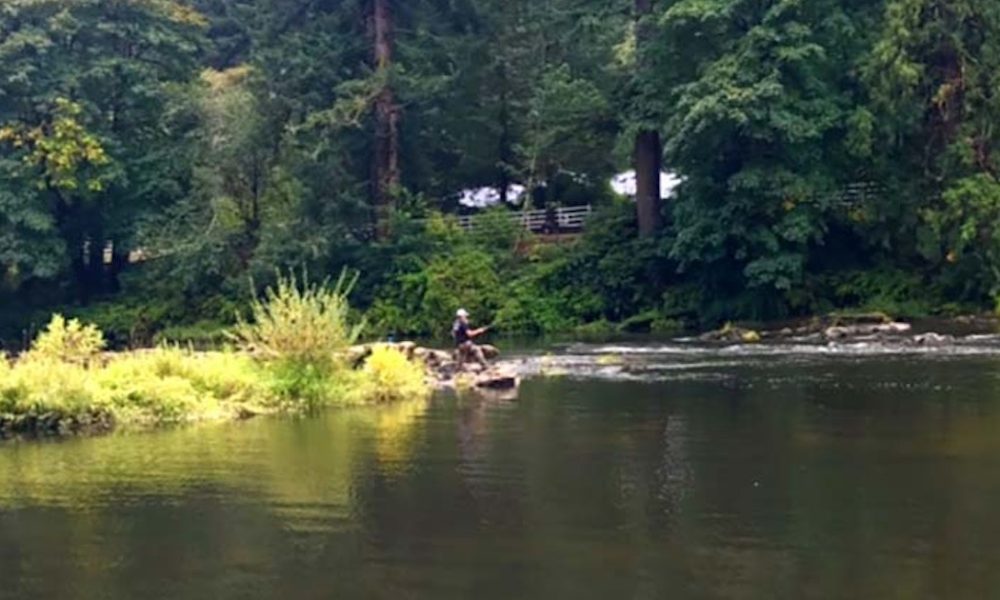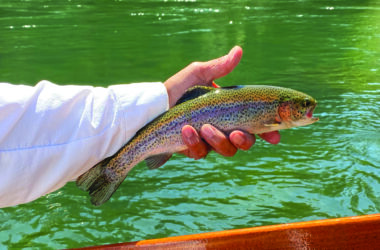 Rain last week brought the Siuslaw River up and anglers took to the banks on the lower river. The holes at Davis Slide and Rain Rock rapids are some of the best salmon holes on the lower Siuslaw. Frank Armendariz/THE CHRONICLE
Rain last week brought the Siuslaw River up and anglers took to the banks on the lower river. The holes at Davis Slide and Rain Rock rapids are some of the best salmon holes on the lower Siuslaw. Frank Armendariz/THE CHRONICLE
It is late September and at the top of the report is the good salmon fishing that has continued along the coast – in the bays, estuaries and now in many coastal rivers including the Siuslaw River. Salmon have spread to where bank-bound and small-boat anglers can reach them.
In a 48-hour period last week, western parts of Lane County accumulated an average of four inches of rain. Some locations on the west slope of the coast mountains received close to six inches from what was an unusually wet early fall rainstorm.
The Siuslaw River rose to about six feet at the Mapleton gauge, which puts the river into a driftable water height that has lasted into the weekend. Chinook were caught from the lower bay all the way upriver to the salmon deadline at the mouth of Lake Creek.
The water levels should hold at about 3.5 feet through next week, allowing more salmon to move upriver on every high tide, offering bank and small-craft anglers good conditions to catch them in the lower river.
Just a reminder, fishing is not allowed on the Siuslaw above Lake Creek until steelhead season opens on Dec. 1. Lake Creek, the Siuslaw’s largest tributary, is also closed to fishing until the Dec. 1 steelhead opener. There are no hatchery coho planted in the Siuslaw, and with only the occasional hatchery straying from other rivers, expect to target only the chinook. For king salmon in the river my go-to is bobber with eggs or shrimp, fished in the deep holes. I still catch a few wild coho on bait, which have to be released, but the slow-moving bait is not what most coho in the river hit.
The most dependable way to tell the difference between a coho and a chinook is to look at the mouth. Chinook have a black mouth and the mouth of a coho is mostly white.
In a personal watercraft like a pontoon boat, the lower Siuslaw can be floated at a level all the way down to 3.5 feet at the Mapleton river gauge. I like 4.5 feet of water for drift-boating the same stretch.
To find the perfect river levels for fishing and drifting on the Siuslaw and other Oregon rivers visit: http://www.rivertrailoutfitters.com/contact.html.
Ocean conditions got pretty rough last week and limited the number of anglers able to fish offshore. The storm mixed the water columns, cooling the tuna bite and pushing them a little further offshore, now about 30 to 40 miles. Winchester Harbor, Depot Bay and Newport Harbor are still among the most productive ports for sport tuna anglers. But, where the average was about seven tuna per angler a couple weeks ago, the number is now about 2.5 to four fish per angler.
The tuna season is winding down but it was a record year for Oregon tuna: 102,000 fish were harvested this season, which far exceeded the previous best of about 63,000 in 2012.
The rough ocean also slowed the pressure on the halibut fishery and will likely have the effect of running the halibut season to its closing dates at the end of October. You should be aware that in the Cape Falcon to Humbug Mountain zone, the ODFW in mid-September opened the All-Depth Halibut Fishery to include all other species of in-season bottomfish. With plenty of halibut left on the allotment, the All-Depth Fishery is open Friday, Saturday and Sunday through October.
For the Nearshore Halibut Fishery, conditions have also keep the sport fleet of boats off the ocean, but the ocean should calm a bit this next week as high pressure will settle in over the nearshore waters. The success rate should increase.
Over in the valley, the McKenzie River was recently planted for the last time this season. A total of about 4,000 trout were spread through the river from Hendricks Wayside to Finn Rock. For the first time in a couple of years those hatchery fish are the Cape Cod strain raised at Leaburg Fish Hatchery. A free raising trout, the Cape Cod strain is well adapted to the McKenzie River’s cold water and steep gradient. Unable to reproduce in the river, which allows wild trout to thrive, these hatchery fish have been part of a bustling river business for a couple of decades and it’s good to see them return. Trout fishing generally holds up through October.
Now go fishing! Take your kids or a friend. Those will be some of the best memories of your life.
Frank Armendariz can be reached at [email protected].








